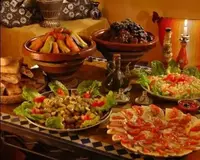The moroccan

Despite the fact that African Morocco is only a few kilometers apart from European Spain, the contrast between the cuisines of these two states is unusually great. It should be noted that the Moors (modern inhabitants of Morocco) influenced South European cuisine quite strongly through the use of exotic fruits, as well as their culinary techniques. In turn, Moroccan cuisine was influenced by many other cultures, such as Arab, Jewish and French.
Moroccan dishes clearly show a balance of decadence and simplicity that directly depends on the season. Popular meats include lamb, camel, beef and chicken. The main source of carbohydrates is couscous, bread, legumes and rice, as well as regular consumption of vegetables, root crops, a variety of greens and seasonal fruits.
According to the recipes of Moroccan cuisine, dishes are usually cooked slowly and very carefully, seasoning them with numerous spices and fresh spicy herbs. We can say that as much as this country is full of contrasts, its national cuisine is so unusual, where in one dish it is not uncommon to mix sweet, salty and spicy. So, dried fruits or fruits in fresh form are often added to meat dishes. A striking example of this is popular national dishes, which simultaneously include beef and quince, lamb and dates (dried apricots, prunes, raisins or pine nuts).
It is customary to serve an amazing abundance of dishes on the traditional Moroccan table, and according to custom, guests should express their pleasure from food. As for the appliances, during lunch, everyone should eat here with the help of their hands, namely their index, middle and thumb. At the beginning of the meal, a large bowl is often served, filled with hot water with a barely tangible aroma of rose water - this vessel is intended for washing hands.
Sometimes lunch starts with soup - the first courses of Moroccan cuisine are very satisfying and thick. The first at the end of the Ramadan fast are served "Harira" - lamb soup with beans and coriander, as well as "Chorba" - chicken broth with a small amount of spices.
Often, the soup is followed by baked meat, mainly lamb. "Pastilla" is the name given to a traditional dish in Morocco that is meant for big celebrations, such as meeting an important guest or wedding. This is a rather complex dish consisting of meat from pigeons, boiled eggs and almonds. Moreover, all this filling is laid between the layers of traditional very finely rolled Moroccan dough. They say that the more layered Pastilla is, the higher the invited guest is valued.
In addition, at the beginning of lunch they can treat you to the traditional seasonal "Tajin" made of beef, pine nuts and raisins. "Couscous" is usually served when lunch is nearing its end, but is used informally as a side dish to "Tajin. " By the way, couscous (grains of semolina) is one of the main components included in the recipes for Moroccan cuisine.
During the entire lunch, "Xra" is transmitted in a circle - homemade bread, an integral part of which is small vases with salt and cumin.
Rounding out Morocco's traditional lunch are sweet patties with a variety of toppings and seasonal fruit served with very sweet mint tea. Although wine is produced in this country, Muslim culture completely prohibits the use of alcohol, and therefore this drink is rarely served at lunch.
 Español
Español Français
Français Português
Português Русский
Русский 简体中文
简体中文 繁體中文
繁體中文 日本語
日本語 한국어
한국어 العربية
العربية Türkçe
Türkçe Қазақ
Қазақ Deutsch
Deutsch Italiano
Italiano Українська
Українська
